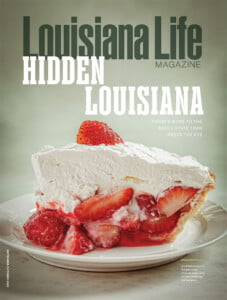From the Executive Editor: Gaspergou – The Fish That No One Loves

In this issue, themed to the state’s claim of being the “Sportsman’s Paradise,” I choose to lower the caliber of the discussion by raising the question of what the least lovable catch from the state’s water is. A case could be made for menhaden, often stacked in smelly piles after being dredged from the gulf, particularly at Cameron Parish. But it is not really an eating fish. Its salvation comes from its oils, some used for cosmetics or vitamins. Another fish, mullets, are best known for their skill at leaping above and back in the water, but they seldom escape the label of junk fish.
There is one fish, though, that most often makes the top, or should it be the bottom, of the least favorable edible inhabitants in our paradise: Meet the gaspergou.
Even if everything else was okay within its world, this critter of the sea is already haunted with one of the ugliest names of the aquatic species. Imagine: “Hey mom, what’s for dinner tonight?”
“Oh, honey, we have a bowl of gaspergou!”
“Mom, can I go to dinner at Colinda’s house?”
To make matters worse, the fish is commonly referred to just by its last syllable. Imagine anticipating a serving of “gou.”
A member of the drum family, the fish is sometimes referred to by the more Americanized version of “freshwater drum.” But in French Louisiana, the Gaullist name clings.
It is a fish with a long history in Louisiana. In 1758 Antoine-Simon Le Page du Pratz, a French naturalist, wrote that the species is “an excellent fish; it is usually 12 to 18 inches; its body round with gilded scales; in its mouth it has two bones shaped like a file, with which it crushes … shells.”
Du Pratz’s mostly positive review might be attributed to his experiencing the fish in a way that a Frenchman would relate to: “Its flesh, though delicate, is very firm; it is best when eaten with red wine.”
Therein is part of the problem. Because of its firmness, the gou is not considered to be a good fish for frying, and that’s how most people prefer their plunder — with a chilled beer on the side.
A more contemporary commentator, fishing columnist Jerald Horst writing in a 2015 issue of Louisiana Sportsman magazine said that the gaspergou “has to be the most disrespected large freshwater fish in Louisiana and probably the whole United States.”
For those with a rod and reel “when the fish comes to the surface, the refrain is always the same, ‘Oh, it’s only a gou’.”
As a kid, my experience with gou was over dinner at my grandparents’ house in Avoyelles Parish where the fish most likely came from the Atchafalaya River. A portion of gou, looking like some sort of stew, was spooned over rice. To that point in my life, my most common seafood experience was fish sticks with a blob of catsup. Gaspergou was something shockingly different. It was served from a bowl mixed with a gravy of some sort. I did not like it — at all. It had an oily taste that was well — fishy.
According to Horst, favored recipes for gou often include smothering the fish, to hide the taste, with some sort of red sauce, though he did find some promise from grilling.
We learn from the gaspergou that just because it is from a Sportsman Paradise does not mean that it always represents beloved cuisine. Nevertheless, it is part of the lore and outdoor adventure that comes with the thrill of the catch.
Just keep a bottle of red wine nearby.

Errol Laborde
Executive Editor
Errol@Louisianalife.com
Louisiana Insider
Catch up on the latest podcast episodes
Episode 183
Dark Roast? Chicory? A Louisiana Coffee’s Second Century
Here is a dash of chicory for your daily podcast listening. The Louisiana-based Community Coffee company is now in its 105th year. Headquartered in Baton Rouge with facilities in New Orleans, Community is the largest family-owned and operated retail coffee brand in the country and a top selling brand not only in Louisiana but throughout the South. GUEST: Matt Saurage, the fourth generation owner and Chairman of Community.
Episode 182
Making a Scene – Louisiana in the Movies
Louisiana was the location for the very first Tarzan movie, back in 1917 when actor Elmo Lincoln swung from the trees near Morgan City where the Atchafalaya Swamp played the role of Africa. Louisiana has produced many more settings including for the early burlesque comedians Abbott and Costello whose rocket flight to Mars misfired and they landed in New Orleans where the day happened to be Mardi Gras, and they mistook the street maskers for Martians. GUEST: Alfred Richard, a film critic whose gigs include a weekly appearance of WWL TV’s morning news and frequent appearance on WYES TV’s “Steppin’ Out.”
